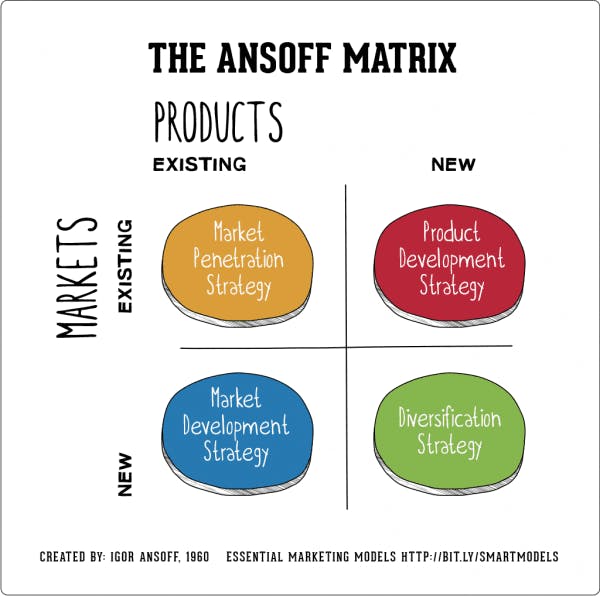In a world where consumer preferences are constantly evolving, the innovation of products and services is vital for any brand that hopes to succeed. This innovation is often expressed when brands develop new products and services to satisfy their consumers. When done right, it helps the brand maintain market relevance, boost revenue, deepen its value proposition and maintain a generally healthy relationship with its consumers.
A study by Professor Clayton Christensen from Havard Business School showed that approximately 30,000 consumer products are launched to market each year and about 95% of them tend to fail. This means that launching a new product or service into any kind of market is one thing, but getting it to generate the much-needed revenue is another. This is where the Ansoff Matrix comes to play!
What Is The Ansoff Matrix?
The concept of optimizing a new product in an existing market is an extract from the Ansoff Matrix founded by H. Igor Ansoff and first published in the Havard business review in 1957. The matrix which is commonly called the product-market expansion grid is a two-by-two framework used by marketing leaders to Identify and evaluate growth opportunities. The grid is particularly helpful for management in conceptualizing the risks associated with various growth strategies.

smartinsights.com/marketing-planning/create..
The focus of this article will be the top right segment of the matrix— Introducing a new product to an existing market. The term ‘market’ in this context could be viewed from the geographical perspective (location), or the demographical perspective (age, gender, socio-economic class). From the matrix, the product development strategy is the go-to strategy for a brand looking to launch a new product in an existing market. It is a strategy commonly utilized by brands that have the ears of a particular market and have gained brand loyalty from that audience segment. In fact, some of the most successful brands are brands that have used consumer loyalty to their advantage. Brands such as the Nivea personal care brand, and Hubspot, a digital marketing hub are great examples.
What is product development?
Product development is a series of steps that encompasses the entire journey of a product or service from ideation to design, development, and market launch. A product development strategy is a process of bringing a new product into an existing or new market by doing continuous market research, thorough testing, and careful product concept planning.
Optimizing A New Product In An Existing Market
Now that we’ve established product development as the go-to strategy for launching a new product in an existing market, let’s learn how. First, there are 7 steps in a product development process. Before you consider optimizing the process, you ought to be familiar with the product development process itself. Understanding how to uniquely optimize your product/service is vital because what works for brand A may not work for brand B.
1. Understand the pain points of your target market.
Understanding the pain points of your target audience will help you avoid being just another short-lived product. What problem are you solving? Will your product/service ease the burden? Thoroughly understanding your target audience's pain point will help your brand develop an authentic and relatable unique selling proposition.
2. What are the opportunities available in the market for your product or service?
When you are able to view the market from the perspective of your target audience it is easier to discover the actual potential of your new product or service. Take the COVID-19 pandemic for example. The world was kept on lockdown yet consumer needs had to be met. Thus, delivery services became the order of the day, and smart brands that were actively doing business through physical stores shifted to online stores. The pandemic presented an opportunity and they took it.
3. Get your customers in the loop early
Involving your customers in the development process well before launch will not only help you understand how they feel about your product or service but will serve as a means of creating awareness before the product or service hits the market. You can determine what point in the process to include your customers. They could be involved in the design aspect, if it's a product then perhaps the material, packaging, and even pricing. One of the best ways to do this is through surveys. Although surveys alone may not give you a precise state-of-mind reading of your target market thus it should be backed up with proper research.
4. Set apart a team for the project.
It is important to dedicate a group of people that can be held accountable for the successful execution of the launch. Your team should comprise of relevant departments to aid the launch with emphasis on R&D. The entire product development process is a research-intense process and as such, you need your best hands on deck. It is not enough to just dedicate a team but empower them with the resources they need to ease the load.
5. Use the best pricing strategy possible.
Having determined the best way to go about developing that new product/service that suits your target audience, you’d want to employ a pricing strategy that satisfies your market while meeting your profit target.
Your pricing strategy should be determined by your objectives, your audience, similar market price, and cost of production amongst others. A great pricing strategy for launching a new product/service into a new market is the New-Product pricing strategy. This strategy comprises two types of pricing— price-skimming and market penetration pricing.
In price-skimming, brands typically set a high price at first to skim maximum profit from certain market segments and then step-wisely lower the price to include other market segments. A typical example would be Apple. When their phones first came out, it was only affordable to those who simply wanted the gadget and could afford it (the early adopters). It was not mass market. After a few months, the price began to drop lower and lower to attract other market segments. However, this pricing style is mostly used for innovative products and not products with very tight competition. Price skimming gets you higher returns on investment, helps segment your market, and early adopters help to test the new product.
The Market penetration pricing on the other hand is quite the opposite of price skimming. Here you set a low price for your new product to entice customers to purchase. It is a commonly used pricing strategy for new products because it helps the brand gain substantial ground on market share. The goal of this strategy is to gain customers from competitors, generate substantial demand, and capture market share. This strategy is best implemented when there is little product differentiation; for example – an FMCG product like milk targeted at the general public. For this strategy to work, the market must be highly competitive, and highly price-sensitive, the brand must be ready to maintain the low-price position otherwise a switch could greatly affect sales and overall brand image.
In conclusion
There will always be new product/service ideas to develop. In fact, someone is thinking up another one as we speak. The gold of the matter is in being intentional from the ideation stage. It is in being customer-centric at every point of the process. This will help you discover unique ways to optimize the development process in a way that serves both you and your audience. Putting in the extra effort will keep you from being another name on the island of ‘could’ve been’ products.


